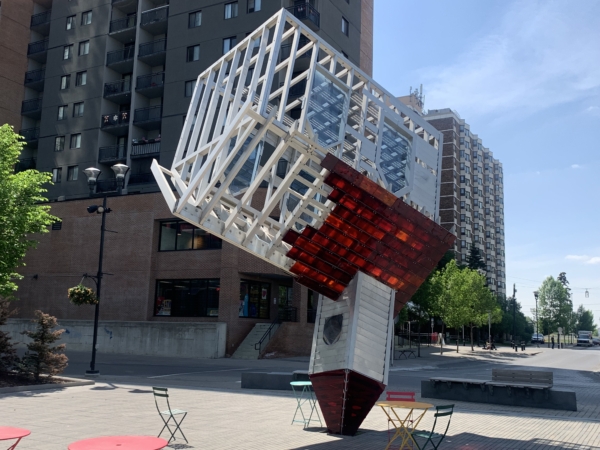
It wasn’t until the beginning of this summer that my husband and I could finally fulfill our long-held plans to visit our daughter, who had moved to Calgary in the middle of Covid in 2020. Exploring this dynamic city for the first time, it was exciting to spot several works by artists I immediately recognized from their work in Toronto, greatly expanding my understanding and appreciation of each one, along with Calgary’s extensive public art program.
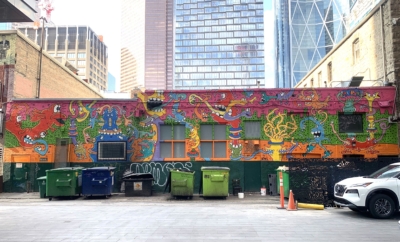
Mural by Runt in the laneway behind Le Germain, Calgary
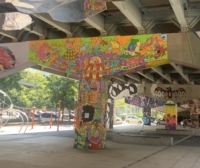
Pillar by Runt in Underpass Park
Arriving at our hotel, Le Germain, I was struck by this mural in the laneway behind the hotel. I suspected (correctly!) that it was the work of Runt, whose Dr. Seuss-like aesthetic adorns Lee’s Palace on Bloor Street West, some pillars in Underpass Park, and several storefronts on Queen St. East. I wasn’t aware that Runt (whose real name is Alex Currie) had done work outside of Toronto, but soon learned that it had been painted as part of Calgary’s BUMP [Beltline Urban Murals] Festival in 2019, a community-led, artist-focused annual event that began in 2017 to invigorate public space. To date the BUMP Festival has transformed Calgary with over 180 public art installations. It was the perfect welcome mat!
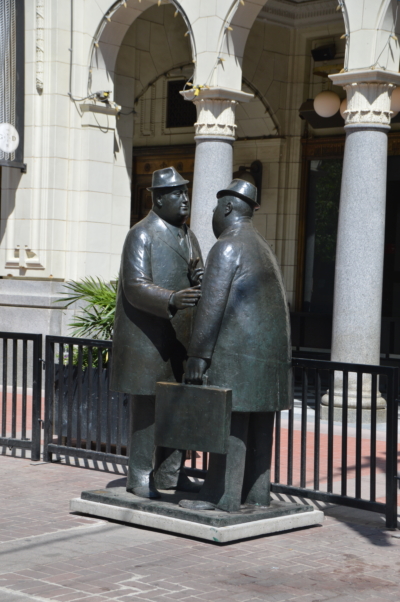
“The Conversation”
Walking along Stephen Ave. just a block from our hotel I stumbled upon this work by William McElcheran, whose satirical portrayals of the modern businessman can be found on the campuses of York University and the University of Toronto.

“The Encounter” at York University
Commissioned by Norcen Energy Resources Limited in 1978, the sculpture, titled “The Conversation,” was later donated to the City of Calgary Public Art Collection. In the mid-1970s, McElcheran (1927-1999) retired to Pietrasanta, Italy, where he remained for the remainder of his life, to work with the foundries patronized by sculptors such as Henry Moore, Louise Bourgeois, Jeff Koons and Fernando Botero. After I learned this, the influences of these renowned contemporary artists, particularly Koons and Botero, seem more apparent in his work.
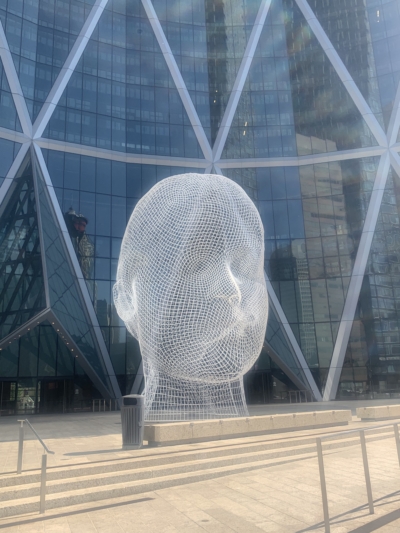
“Wonderland”
When Jaume Plensa’s “Dreaming,” a mysterious portrait of a face, was installed in the Richmond-Adelaide Centre in 2017, it was heralded for its innovative, surrealistic style.

“Dreaming”
Since then, the marble and resin portrait has become an iconic work, expressing the artist’s hope for universal human fulfillment. To my surprise, I discovered that it is only one of a number of similar works in a series by the artist that can be found in many locations throughout the world from Los Angeles, to Germany, South Korea, New York, Madrid and other places. Some are fashioned in resin and stone, while others are constructed in wire mesh.
“Wonderland,” pictured here, and commissioned by Encana Corporation, was installed in 2012 at The Bow, the company’s headquarters in downtown Calgary, where it has become a kind of landmark. 10 metres high, the massive work features two entrances, allowing visitors to walk underneath it, into a kind of cavernous domain of the human mind or spirit. There is more here than meets the eye; Plensa thinks deeply about the very conditions of human existence, the relationship between human consciousness and physicality; our relationship with nature; light and darkness; silence and sound.
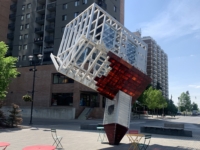
“Device to Root Out Evil”
On another day, my husband and I made our way to the Studio Bell, passing through 5th Street Square in East Village, where we encountered this inverted church. Titled “Device to Root Out Evil,” I learned that it was the work of Dennis Oppenheim, the late NY conceptual artist whose 12-metre tall work “Still Dancing” sits in Trinity Square in Toronto’s Distillery District.

“Still Dancing”
Oppenheim was a pioneer in conceptual, earth and bodily art and his works are featured in the collections of many important museums, including the MOMA and the LACMA. Fabricated of galvanized steel, perforated metal and Venetian glass, the work, initially titled “Church,” was funded by New York City’s Public Art Fund and was to have been installed on Church Street in NYC where Oppenheim lived at the time. After it was completed, though, it was considered too controversial, and was renamed and re-installed as part of the 1997 Venice Biennale. It was subsequently purchased by Stanford University in 2003 but never exhibited after the university’s president declared it “inappropriate for campus.”
Since then it has been exhibited in Vancouver and Mallorca, until making its way to Calgary in 2019. Gazing at “Device to Root Out Evil,” I thought about what it might mean to direct the steeple of a church into the ground instead of toward heaven. The aspirations of religion are too often inverted and subverted; it is frequently a source of immorality, and throughout history has been the cause of great human conflict and war. I’m surprised that this work would be too controversial for supposedly enlightened outposts as the campus of Stanford or the streets of lower Manhattan — but rather impressive that Calgary has welcomed it, even if on a temporary basis.
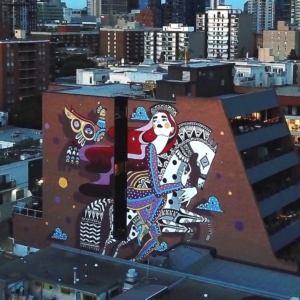
“Into the Light”
While taking in the spectacular view from my daughter’s apartment, I spotted this stunning mural on the side of a large building nearby. Something about the woman’s face, the vibrant colouring and distinctive patterning looked strangely familiar but I couldn’t quite place it…Titled “Into the Light,” it was painted by Ola Volo, a Canadian artist who was born in Kazhakstan for the 2020 BUMP Festival, and has painted murals all over the world. Her work employs folk motifs from her culture to express themes of multiculturalism and identity. This mural conveys a message of empowerment, envisioning a world without prejudice, where people are free to choose their own path.
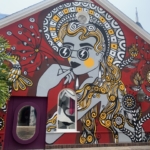
“Untitled,” Ola Volo
After returning to Toronto, I found myself in the courtyard of 99 Yorkville Ave., when I suddenly made the connection: this mural on the side of the Christian Louboutin store was painted by Volo for the 2019 Yorkville Murals Festival! It was a reminder of the need to take time to fully appreciate the ever-growing collection of international Street Art.
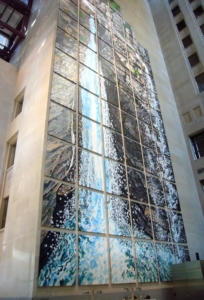
“Johnston Canyon”
Finally, no trip to Calgary would be complete without a trip to Banff, and ours was no exception. A memorable highlight was a hike to Johnston Canyon Waterfall,  which until then had only resided in my imagination, thanks to Derek Besant’s spectacular 23-metre tall mural, one of my favourite works of public art in Toronto, that is installed in the Scotia Plaza. The thrill of seeing the real thing simply took my breath away.
which until then had only resided in my imagination, thanks to Derek Besant’s spectacular 23-metre tall mural, one of my favourite works of public art in Toronto, that is installed in the Scotia Plaza. The thrill of seeing the real thing simply took my breath away.


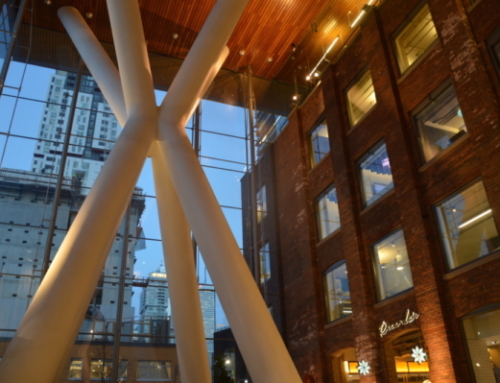
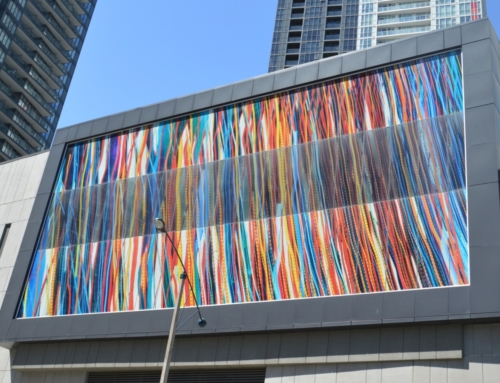
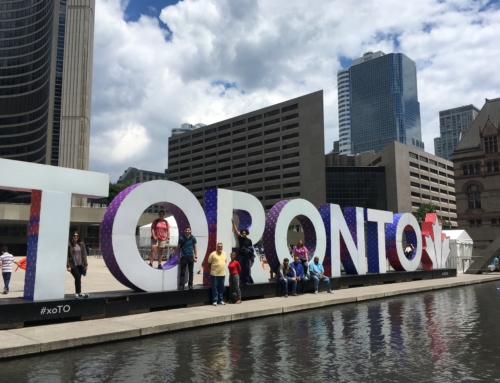
Leave A Comment